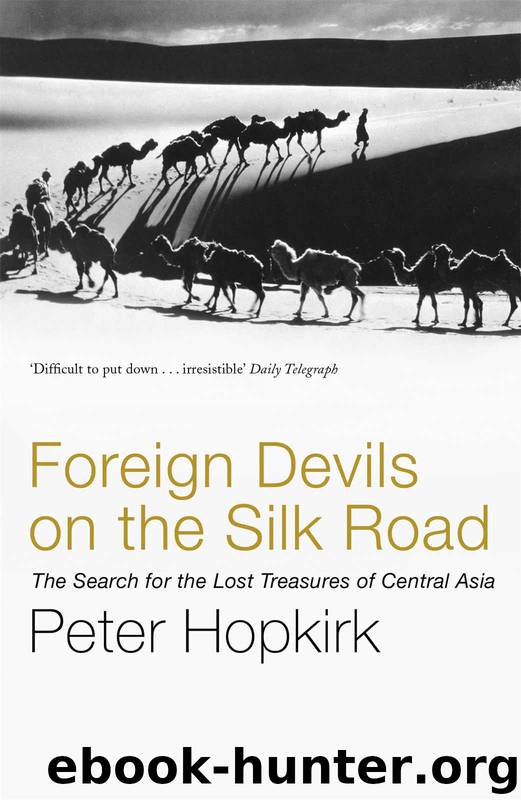Foreign Devils on the Silk Road: The Search for the Lost Treasures of Central Asia by Peter Hopkirk

Author:Peter Hopkirk [Hopkirk, Peter]
Language: eng
Format: azw3, epub
ISBN: 9781848546325
Publisher: Hodder & Stoughton
Published: 2011-09-15T04:00:00+00:00
9. Von Le Coq Spins a Coin
* * *
The Buddhist monks who a thousand years ago built the great monastery complex at Bezeklik chose its position with ingenuity. Even in von Le Coq’s day a visitor to this remote and dramatically barren region could pass quite close to the site without realising it was there. Its hundred or so temples, mostly hewn out of the rock, occupied a long narrow terrace perched high on a cliff face. The only approach was by climbing a winding pathway leading to, and then along, the cliff-top. From there a precipitous stairway descended to the monastery some thirty feet below. Only from one spot could it be seen, and to ensure both security and privacy the architects had built a wall to block this view from the eyes of passers-by. Today this vast honeycomb of temples still stands, leaving a profound impression on the visitor brave enough to face the rugged drive there. But the name of Albert von Le Coq is not one to conjure with locally.
On arrival, the two Germans set up their headquarters in an old temple building, at one time inhabited by goatherds, at the southern end of the monastery complex. The walls of this, and other temples around it, had once borne murals, but these had been ruined by smoke from the goatherds’ fires. Von Le Coq and Bartus decided therefore to investigate those temples at the northern end of the terrace. For these had been protected from occupation by the sand which over the centuries had cascaded down from the hills above, filling them from floor to ceiling. Entering one of the largest, von Le Coq clambered unsteadily along the heap of sand piled high against the wall. Immediately, the movement of his feet started a small avalanche beneath him. ‘Suddenly, as if by magic,’ he wrote, ‘I saw on the walls bared in this way, to my right and left, splendid paintings in colours as fresh as if the artist had only just finished them.’ He shouted excitedly to Bartus to come and see this amazing chance discovery. After examining what could be seen of the frescoes, the two men solemnly shook hands, for here was something they knew was likely to prove momentous. ‘If we could secure these pictures,’ von Le Coq wrote in Buried Treasures of Chinese Turkestan, ‘the success of the expedition was assured.’
After laboriously removing quantities of sand, they found themselves staring at six, larger-than-lifesize paintings of Buddhist monks, three on either side of the entrance. More followed as they dug further into the sand-filled temple. Some of the figures were distinctively Indian, wearing yellow robes, and with their names recorded in Central Asian Brahmi script beside them. Others, in violet robes, were clearly from Eastern Asia, their names being written in Uighur and Chinese. Von Le Coq observes in his book that these thousand-year-old portraits were not the usual stereotypes done with stencils, but were attempts at achieving real likenesses.
Continuing their advance
Download
Foreign Devils on the Silk Road: The Search for the Lost Treasures of Central Asia by Peter Hopkirk.epub
This site does not store any files on its server. We only index and link to content provided by other sites. Please contact the content providers to delete copyright contents if any and email us, we'll remove relevant links or contents immediately.
| Africa | Americas |
| Arctic & Antarctica | Asia |
| Australia & Oceania | Europe |
| Middle East | Russia |
| United States | World |
| Ancient Civilizations | Military |
| Historical Study & Educational Resources |
The Sympathizer by Viet Thanh Nguyen(3622)
The Rape of Nanking by Iris Chang(3616)
World without end by Ken Follett(3069)
Ants Among Elephants by Sujatha Gidla(2978)
Blood and Sand by Alex Von Tunzelmann(2676)
Japanese Design by Patricia J. Graham(2621)
City of Djinns: a year in Delhi by William Dalrymple(2185)
Inglorious Empire by Shashi Tharoor(2143)
Foreign Devils on the Silk Road: The Search for the Lost Treasures of Central Asia by Peter Hopkirk(2116)
In Order to Live: A North Korean Girl's Journey to Freedom by Yeonmi Park(2106)
Tokyo by Rob Goss(2067)
India's biggest cover-up by Dhar Anuj(2035)
India's Ancient Past by R.S. Sharma(2033)
The Great Game: On Secret Service in High Asia by Peter Hopkirk(2017)
Tokyo Geek's Guide: Manga, Anime, Gaming, Cosplay, Toys, Idols & More - The Ultimate Guide to Japan's Otaku Culture by Simone Gianni(1992)
Goodbye Madame Butterfly(1979)
The Queen of Nothing by Holly Black(1833)
Living Silence in Burma by Christina Fink(1784)
Batik by Rudolf Smend(1774)
